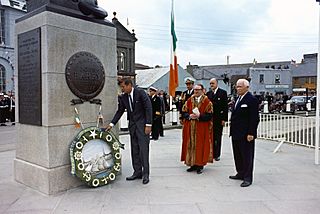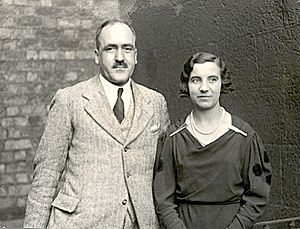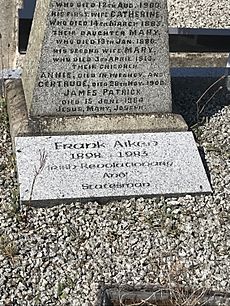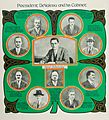Frank Aiken facts for kids
Quick facts for kids
Frank Aiken
|
|
|---|---|
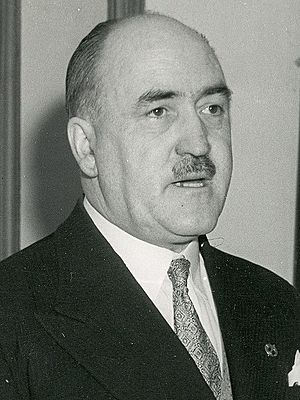
Aiken in 1944
|
|
| Tánaiste | |
| In office 21 April 1965 – 2 July 1969 |
|
| Taoiseach | |
| Preceded by | Seán MacEntee |
| Succeeded by | Erskine H. Childers |
| Minister for External Affairs | |
| In office 20 March 1957 – 2 July 1969 |
|
| Taoiseach |
|
| Preceded by | Liam Cosgrave |
| Succeeded by | Patrick Hillery |
| In office 13 June 1951 – 2 June 1954 |
|
| Taoiseach | Éamon de Valera |
| Preceded by | Seán MacBride |
| Succeeded by | Liam Cosgrave |
| Minister for Finance | |
| In office 19 June 1945 – 18 February 1948 |
|
| Taoiseach | Éamon de Valera |
| Preceded by | Seán T. O'Kelly |
| Succeeded by | Patrick McGilligan |
| Minister for the Co-ordination of Defensive Measures | |
| In office 8 September 1939 – 18 June 1945 |
|
| Taoiseach | Éamon de Valera |
| Preceded by | New office |
| Succeeded by | Office abolished |
| Minister for Defence | |
| In office 9 March 1932 – 8 September 1939 |
|
| Taoiseach | Éamon de Valera |
| Preceded by | Desmond FitzGerald |
| Succeeded by | Oscar Traynor |
| Minister for Lands and Fisheries | |
| In office 3 June 1936 – 11 November 1936 |
|
| Taoiseach | Éamon de Valera |
| Preceded by | Joseph Connolly |
| Succeeded by | Gerald Boland |
| Teachta Dála | |
| In office August 1923 – February 1973 |
|
| Constituency | Louth |
| Personal details | |
| Born |
Francis Thomas Aiken
13 February 1898 Camlough, County Armagh, Ireland |
| Died | 18 May 1983 (aged 85) Blackrock, Dublin, Ireland |
| Resting place | St Malachy's Church, Camlough, Armagh, Northern Ireland |
| Political party | Fianna Fáil (from 1926) |
| Other political affiliations |
Sinn Féin (1923–26) |
| Spouse | Maud Aiken (1934–1978) |
| Children | 3 |
| Education |
|
| Alma mater | University College Dublin |
| Military service | |
| Allegiance |
|
| Years of service | 1914–1925 |
| Rank | General (chief of staff) |
| Battles/wars | |
Frank Aiken (born Francis Thomas Aiken; 13 February 1898 – 18 May 1983) was an important Irish leader and politician. He was a key figure in the Anti-Treaty IRA during the Irish Civil War. Later, he served as Tánaiste (Deputy Prime Minister) from 1965 to 1969. He was also Minister for External Affairs for many years.
Frank Aiken held several other important government jobs. He was Minister for Finance, Minister for the Co-ordination of Defensive Measures (during World War II), and Minister for Defence. He also served briefly as Minister for Lands and Fisheries. He was a Teachta Dála (TD), which is a member of the Irish Parliament, for the Louth area from 1923 to 1973. This made him one of the longest-serving members of the Dáil. He started his political journey with Sinn Féin and later helped create the Fianna Fáil party.
Contents
Early Life and Education
Growing Up in Armagh
Frank Aiken was born on 13 February 1898 in Camlough, County Armagh, Ireland. He was the youngest of seven children. His father, James Aiken, was a builder who constructed Catholic churches. James was also a local leader and a strong supporter of Irish independence. He famously told Queen Victoria during her visit that he would not welcome her until Ireland was free.
Frank went to school in Camlough and then to Abbey Christian Brothers' Grammar School in Newry. He later learned to speak the Irish language in the Donegal Gaeltacht (Irish-speaking area).
Revolutionary Period
Joining the Irish Volunteers
In 1914, Frank Aiken joined the Irish Volunteers, a group that wanted Ireland to be independent. He quickly became a lieutenant. He also joined the Gaelic League, which promoted Irish culture. In 1917, he became involved with Sinn Féin, a political party working for Irish independence. His sister, Nano Aiken, helped set up a local branch of Cumann na mBan, a women's republican organization.
Aiken first met Éamon de Valera, another future Irish leader, in 1917. Aiken was active in organizing and fundraising for the independence movement. He showed his defiance by raising the Irish tricolor flag in Camlough in 1917. In 1918, he was arrested for illegal drilling, which was a way of training for military action. After his release, he joined the secret Irish Republican Brotherhood.
War of Independence Actions
During the Irish War of Independence (1919-1921), Aiken led a very effective unit of the IRA in the south Armagh and north Louth areas. His leadership and training methods were highly praised.
In May 1920, he led about 200 IRA men in an attack on the RIC barracks in Newtownhamilton. They tried to burn the building, but the police inside did not surrender. Aiken's group managed to blast a hole in the wall and enter, fighting with the police.
In December 1920, Aiken led another attack on the RIC station in his home village of Camlough. In response, the Ulster Special Constabulary burned Aiken's home and the homes of ten of his relatives. This made the conflict in the area even more intense.
In April 1921, Aiken's men set up an ambush for police and Special Constabulary in Creggan. One Special Constable was killed. To keep people safe during the crossfire, both Catholic and Protestant churchgoers were held in a pub. In June 1921, Aiken's men derailed a British troop train, which was a significant attack. After an IRA reorganization, Aiken was put in charge of the Fourth Northern Division of the IRA.
The Irish Civil War and Peace Efforts
After the Anglo-Irish Treaty was signed in 1921, the IRA split. Frank Aiken tried to prevent a civil war and remained neutral at first. He believed in finding a peaceful solution. He wrote to Richard Mulcahy, a leader on the pro-Treaty side, suggesting a truce and changes to the Free State constitution to avoid further fighting.
Despite his efforts for peace, Aiken was arrested by pro-Treaty troops in July 1922 and imprisoned in Dundalk. However, he escaped just ten days later in a mass breakout. In August, he led a surprise attack on Dundalk, freeing many republican prisoners and capturing weapons. While in control of the town, Aiken publicly called for an end to the civil war. He remained against the fighting between Irish people. His son later recalled that Aiken would say "terrible things happen in wars and worse in civil wars" when asked about this time.
Becoming IRA Chief of Staff
In April 1923, Aiken was with IRA leader Liam Lynch when Lynch was killed in an ambush. Aiken bravely saved important IRA papers. He then became the IRA Chief of Staff on 20 April 1923.
Aiken worked closely with Éamon de Valera to end the Civil War without a formal surrender. Instead of giving up their weapons, Aiken issued an order on 24 May 1923 for fighters to "dump arms" and return home as honorable republicans. This effectively ended the Irish Civil War. Aiken remained IRA Chief of Staff until November 1925.
Founding Fianna Fáil and Government Roles
Aiken was first elected to the Dáil (Irish Parliament) in 1923 for Sinn Féin. In 1926, when Éamon de Valera formed a new political party called Fianna Fáil, Aiken became a founding member. He was re-elected for Fianna Fáil in 1927 and continued to serve as a TD for 50 years until his retirement in 1973.
He joined the first Fianna Fáil government as Minister for Defence. He was also an inventor, creating things like a special turf stove and a beehive.
Working with the Governor General
In 1932, Aiken was involved in a public disagreement with the Governor-General of the Irish Free State, James McNeill. Aiken and another minister, Seán T. O'Kelly, publicly ignored McNeill at an event. This caused a stir in the media. While the situation was seen as regrettable, Aiken had been working to improve relations between the army and the new government. He visited republican prisoners, who were then released.
Minister During World War II
When World War II began in 1939, Aiken was appointed Minister for the Co-ordination of Defensive Measures. His job was to oversee Ireland's national defense and keep Ireland neutral during the war, which was known as The Emergency in Ireland.
Aiken was responsible for censorship during this time. He believed it was important to control information to protect national morale and maintain neutrality. He expanded the Irish Army significantly, growing it to 41,000 regular soldiers and 180,000 in auxiliary units by 1941.
In March 1941, Aiken went to America to get supplies from the US, as Ireland felt Britain was holding back supplies due to Ireland's neutrality. He had a tense meeting with US President Franklin Roosevelt. Aiken argued that Ireland needed help against "British aggression" as well as German. While he didn't get American arms, he did secure shipments of grain, merchant ships, and coal. Roosevelt also promised that Britain would not invade Ireland.
Leading Irish Foreign Policy
After the war, Aiken served as Minister for Finance for three years. However, it was during his two terms as Minister for External Affairs (1951-1954 and 1957-1969) that he made a huge impact. As Foreign Minister, he worked to make Ireland's voice heard independently at the United Nations and other international groups.
He strongly supported the rights of smaller nations, like Tibet and Hungary, because he felt Ireland could understand their struggles. He also spoke out against apartheid in South Africa and supported countries like Algeria in their fight for self-determination.
Aiken was a big supporter of nuclear non-proliferation, meaning he wanted to stop the spread of nuclear weapons. He was the first minister to sign the Treaty on the Non-Proliferation of Nuclear Weapons in Moscow in 1968. Many people consider Frank Aiken to be the "father of Irish foreign policy" because of his important work in this area.
Later Years and Retirement
Aiken retired from his government roles, including Tánaiste, in 1969. He retired from politics completely in 1973. This was partly because he disliked the political style of Charles Haughey, who was allowed to run as a Fianna Fáil candidate in the 1973 election.
After his retirement, the outgoing President of Ireland, Éamon de Valera, asked Aiken to run for president in the 1973 election. However, Aiken refused, and Erskine Hamilton Childers was chosen instead and won.
Family Life
In 1934, Frank Aiken married Maud Davin, who was the director of the Dublin Municipal School of Music. They had three children: Aedamar, Proinnsias, and Lochlann. Sadly, his wife died in a road accident in 1978.
Death and Legacy
Frank Aiken passed away on 18 May 1983 in Dublin at the age of 85. He was buried in his hometown of Camlough, County Armagh, in Northern Ireland.
Aiken received many awards and honors throughout his life, including honorary doctorates from Irish universities. He also received the Grand Cross of St. Olav, which is Norway's highest honor for a foreigner. He was a lifelong supporter of the Irish language.
Aiken Barracks in Dundalk, County Louth, which is a military base, is named in his honor.
Images for kids


